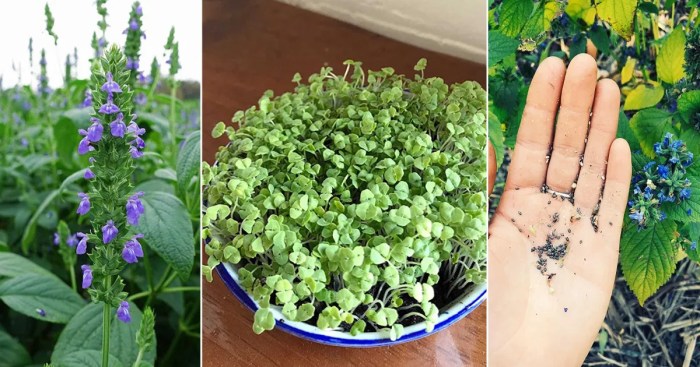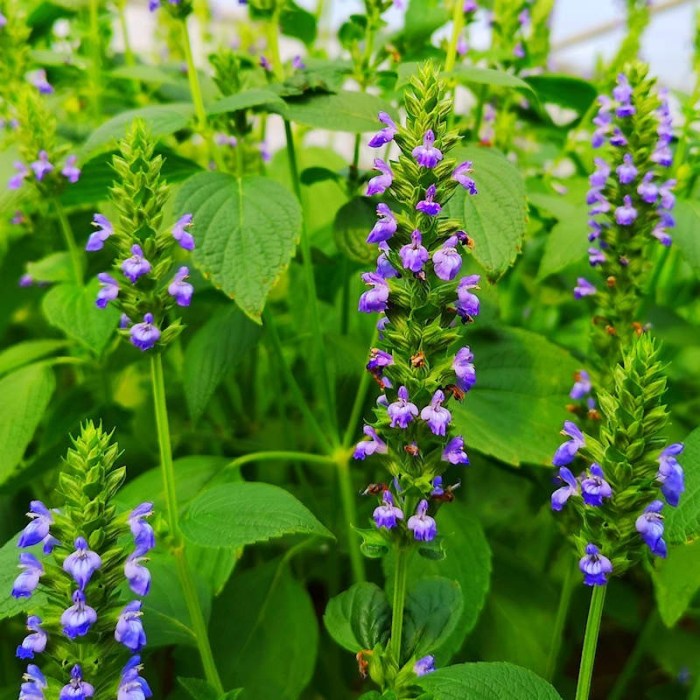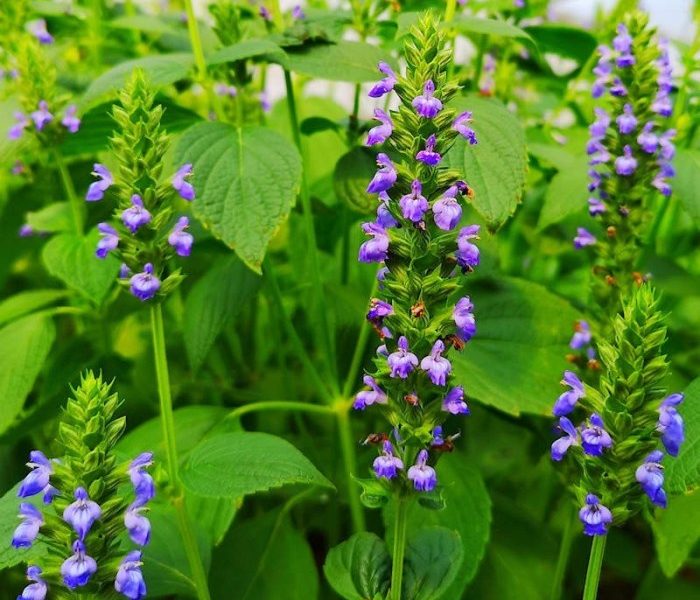Chia Seeds Chia Plant A Tiny Seed, A Big Story
Chia Seed Nutritional Profile: Chia Seeds Chia Plant
Chia seeds chia plant – Chia seeds are a nutritional powerhouse, offering a remarkable concentration of nutrients in a small package. Understanding their nutritional profile can help you appreciate their potential benefits for overall health and well-being. This section will detail the macronutrient and micronutrient composition of chia seeds, highlight their associated health benefits, and offer a comparison with other popular seeds.
Macronutrient and Micronutrient Composition of Chia Seeds
Chia seeds are an excellent source of fiber, healthy fats, and protein. A typical one-ounce (28-gram) serving provides a significant portion of several essential nutrients. The following table details the nutritional breakdown:
| Nutrient | Amount per serving (28g) | % Daily Value | Health Benefit |
|---|---|---|---|
| Fiber | 10g | 40% | Promotes digestive health, regulates blood sugar, and contributes to feelings of fullness. |
| Protein | 4g | 8% | Essential for building and repairing tissues, supporting immune function, and producing enzymes and hormones. |
| Fat | 9g | 14% | Primarily unsaturated fats (omega-3 and omega-6 fatty acids), crucial for brain health, reducing inflammation, and supporting cardiovascular health. |
| Calcium | 180mg | 18% | Essential for strong bones and teeth, muscle function, and nerve transmission. |
| Phosphorus | 270mg | 27% | Important for bone health, energy production, and cell signaling. |
| Manganese | 30% | 30% | Plays a vital role in bone formation, wound healing, and metabolism. |
| Magnesium | 30% | 30% | Contributes to muscle and nerve function, blood sugar control, and blood pressure regulation. |
| Iron | 2mg | 11% | Essential for oxygen transport throughout the body and energy production. |
| Zinc | 2mg | 18% | Supports immune function, wound healing, and cell growth. |
Health Benefits Associated with Key Nutrients in Chia Seeds, Chia seeds chia plant
The high concentration of fiber, healthy fats, and various micronutrients in chia seeds contributes to a range of health benefits. The fiber content, for example, aids in digestive regularity and can help manage blood sugar levels by slowing down the absorption of glucose. The omega-3 fatty acids, particularly alpha-linolenic acid (ALA), are known for their anti-inflammatory properties and potential benefits for cardiovascular health.
The presence of antioxidants helps protect cells from damage caused by free radicals. The high mineral content supports bone health, immune function, and overall metabolic processes.
Comparison of Chia Seeds with Flax Seeds and Sunflower Seeds
While chia seeds, flax seeds, and sunflower seeds are all nutritious options, their nutritional profiles differ. Flax seeds are particularly rich in lignans, a type of plant compound with potential antioxidant and hormone-balancing effects. Sunflower seeds are a good source of vitamin E, a powerful antioxidant, and selenium, a mineral essential for thyroid function. Chia seeds, however, stand out due to their exceptionally high fiber and omega-3 fatty acid content compared to these other seeds.
The best choice depends on individual nutritional needs and preferences. A varied diet including all three can provide a wide range of beneficial nutrients.
Chia Seed Culinary Uses
Chia seeds, despite their small size, offer a surprisingly versatile addition to a wide range of culinary applications. Their mild, nutty flavor and ability to absorb liquids make them a perfect ingredient for thickening, adding texture, and boosting the nutritional value of various dishes. This section explores diverse ways to incorporate chia seeds into your diet, categorized by meal type, and provides guidance on preparing them for optimal consumption.
Chia Seed Preparation Methods
Preparing chia seeds correctly enhances their texture and digestibility. Two primary methods are commonly used: soaking and grinding. Soaking chia seeds in liquid (water, milk, juice) for at least 15 minutes, or preferably longer, allows them to form a gel-like consistency. This gel not only improves their texture but also enhances their absorption of nutrients. Grinding chia seeds, using a blender or food processor, increases their surface area, aiding digestion and nutrient absorption.
This is particularly beneficial for those who experience digestive discomfort with whole seeds. The choice between soaking and grinding depends on the specific recipe and personal preference.
Chia Seed Recipes by Meal Type
Chia seeds seamlessly integrate into various meal types, offering both nutritional and culinary benefits. Below are examples illustrating their versatility.
Breakfast Recipes
Chia seed pudding is a popular and versatile breakfast option. Many variations exist, depending on preferred flavors and ingredients.
A basic chia seed pudding recipe involves combining 1/4 cup chia seeds with 1 cup of your choice of milk (dairy or non-dairy) and a sweetener like honey or maple syrup. Let it sit in the refrigerator overnight to allow the chia seeds to absorb the liquid and form a pudding-like consistency. Add fruits, nuts, or spices for flavor variations.
Another simple breakfast option is adding chia seeds to oatmeal or yogurt. A tablespoon or two added to your morning bowl provides a nutritional boost and adds a slightly crunchy texture.
Lunch Recipes
Chia seeds can be incorporated into salads for added texture and nutrition.
Sprinkle chia seeds over your favorite salad for a boost of fiber and omega-3 fatty acids. Their subtle nutty flavor complements many salad dressings and ingredients.
Chia seeds can also be added to homemade veggie burgers or patties as a binding agent and for added nutrients.
Dinner Recipes
Chia seeds can be used as a thickening agent in soups and stews.
Add a tablespoon or two of chia seeds to your favorite soup or stew towards the end of cooking. They will absorb the liquid and create a slightly thicker consistency.
Snack Recipes
Chia seeds can be added to homemade energy bars or muffins for a nutritional boost.
Incorporate chia seeds into your favorite energy bar or muffin recipe for added fiber and healthy fats. Their presence is often barely noticeable in terms of taste but significantly enhances the nutritional profile.
Just as the tiny chia seed holds immense potential for growth, so too does your garden. Consider the artistry of nurturing life, much like learning how to plant hostas around a tree to create a thriving landscape. This thoughtful approach mirrors the care needed to cultivate a bountiful chia plant, ensuring its flourishing and the reward of its tiny, powerful seeds.
A simple and healthy snack is a mix of chia seeds, nuts, and dried fruits.
Chia Seed Texture and Flavor Profile Comparison
The texture and flavor profile of chia seeds vary depending on preparation and recipe.
| Recipe | Texture | Flavor Profile |
|---|---|---|
| Chia Seed Pudding | Gelatinous, smooth | Mildly nutty, subtle |
| Oatmeal with Chia Seeds | Slightly crunchy | Subtle nutty flavor, blends well with other ingredients |
| Salads with Chia Seeds | Slightly crunchy | Adds a pleasant textural contrast, subtle nutty flavor |
| Soups/Stews with Chia Seeds | Slightly thickened, barely noticeable | Minimal flavor impact, mainly contributes to texture |
| Energy Bars/Muffins with Chia Seeds | Slightly crunchy, incorporated into the overall texture | Minimal flavor impact, largely unnoticeable |
Chia Plant History and Geography
The chia plant,Salvia hispanica*, boasts a rich history deeply intertwined with the cultures and landscapes of the Americas. Its journey from ancient Mesoamerican staple to modern-day superfood reveals a fascinating story of cultivation, adaptation, and enduring cultural significance. Understanding this history provides a deeper appreciation for the plant’s remarkable properties and its continued importance globally.The origins of chia cultivation are firmly rooted in Mesoamerica, specifically in present-day Mexico and Guatemala.
Archaeological evidence suggests chia was a crucial part of the diet of various pre-Columbian civilizations, including the Aztecs and Maya, dating back thousands of years. These ancient cultures valued chia not only as a nutritious food source but also for its medicinal and ritualistic properties. Its widespread cultivation and use across a significant geographical area during this period highlight its importance within these societies.
Ancient Mesoamerican Cultivation and Significance
Chia held a prominent position in the agricultural systems and daily lives of the Aztec and Maya. It was a vital component of their diets, providing a significant source of energy and essential nutrients. Beyond its nutritional value, chia seeds played a significant role in religious ceremonies and rituals. Depictions of chia plants and seeds have been found in ancient artifacts, reinforcing its cultural and spiritual importance.
Furthermore, the seeds’ ability to be stored for extended periods made them a valuable asset, contributing to food security in these societies. The extensive cultivation practices employed by these civilizations demonstrate the plant’s adaptability to various environmental conditions and its integral role within their agricultural systems.
Global Distribution and Modern Cultivation
Following the Spanish conquest of Mexico, chia cultivation diminished significantly in many regions. However, the plant persisted in certain areas, and its cultivation has experienced a remarkable resurgence in recent decades. Today, chia is grown commercially in several countries, including Mexico, Argentina, Bolivia, Australia, and Paraguay. These regions benefit from suitable climatic conditions, including warm temperatures and ample sunlight, that are conducive to chia cultivation.
The growing global demand for chia seeds has driven expansion of cultivation efforts, making it a significant crop in many parts of the world. The increased global demand reflects a growing awareness of the nutritional benefits and versatility of chia seeds.
Key Regions of Modern Chia Production
Mexico remains a leading producer of chia, reflecting its historical significance as the plant’s center of origin. However, other countries have emerged as significant players in global chia production. Argentina, in particular, has experienced substantial growth in chia cultivation, becoming a major exporter of chia seeds to international markets. The successful cultivation in these diverse regions highlights the plant’s adaptability and its potential for sustainable agricultural practices in various environments.
This diversification of production ensures a more resilient supply chain and reduces the risk of shortages associated with relying on a single source of production.
Chia Seed and Plant Sustainability

Chia seeds, while offering a wealth of nutritional benefits, also present considerations regarding their environmental impact. Understanding the sustainability of chia production is crucial for ensuring its long-term viability and minimizing its ecological footprint. This section will explore the environmental impact of chia cultivation, comparing it to other seed crops and outlining a potential model for more sustainable farming practices.The environmental impact of chia seed production is primarily linked to water usage and land requirements.
While chia is relatively drought-tolerant compared to some crops, its cultivation still necessitates significant water resources, particularly in arid and semi-arid regions where it’s often grown. Similarly, the expansion of chia farming could lead to land-use change, potentially impacting biodiversity and natural habitats. The intensity of these impacts varies depending on farming practices, irrigation methods, and the specific geographical location.
Water Usage in Chia Production
The amount of water used in chia cultivation varies considerably based on several factors, including climate, soil type, irrigation techniques, and farming practices. In regions with naturally lower rainfall, supplemental irrigation is often necessary, leading to higher water consumption. Efficient irrigation methods, such as drip irrigation, can significantly reduce water waste compared to flood irrigation. Furthermore, the selection of drought-resistant chia varieties and appropriate soil management practices can contribute to minimizing water usage.
For example, a study conducted in Mexico showed that using drip irrigation reduced water consumption by approximately 30% compared to traditional flood irrigation methods. This highlights the importance of adopting water-efficient technologies and farming practices to lessen the environmental impact.
Comparison to Other Seed Crops
Compared to other seed crops, chia’s water footprint can vary. While it may require less water than certain water-intensive crops like rice or almonds, its water usage might be comparable to or even exceed that of other oilseeds like flax or sunflower, depending on the specific growing conditions and farming practices. A comprehensive comparative analysis across different regions and farming systems is necessary to accurately assess chia’s relative water footprint.
This analysis would consider factors like yield per unit of water used (water-use efficiency) and the overall environmental impact of the entire production process, from seed to market. Such studies are crucial for informed decision-making regarding the sustainability of chia cultivation.
Sustainable Chia Farming Model
A hypothetical sustainable chia farming model would integrate several key strategies to minimize environmental impact. This model would prioritize water conservation through efficient irrigation techniques like drip or micro-sprinkler systems, coupled with rainwater harvesting and soil moisture monitoring technologies. Furthermore, it would incorporate crop rotation and cover cropping to improve soil health, reduce erosion, and minimize the need for synthetic fertilizers and pesticides.
The selection of drought-tolerant chia varieties would further enhance water-use efficiency. Finally, the model would involve responsible land management practices to protect biodiversity and prevent habitat loss. Such a model, implemented on a larger scale, could significantly reduce the ecological footprint of chia production and contribute to a more sustainable agricultural system. For instance, a farm adopting this model could aim to reduce its water consumption by 40% and increase its yield per hectare by 15% within five years, based on implementing best practices.
Chia Seeds in Health and Wellness

Chia seeds, small but mighty, are increasingly recognized for their contributions to overall health and well-being. Their nutritional profile, rich in fiber, omega-3 fatty acids, and antioxidants, supports various aspects of health, from weight management to digestive regularity. This section will explore the specific ways chia seeds can benefit your health.
Chia Seeds and Weight Management
Chia seeds can play a valuable role in weight management strategies. Their high fiber content promotes satiety, meaning you feel fuller for longer after consuming them. This can lead to reduced overall calorie intake. Furthermore, the fiber in chia seeds helps regulate blood sugar levels, preventing energy crashes and subsequent cravings. Studies have shown that incorporating chia seeds into a diet can contribute to weight loss or weight maintenance, particularly when combined with a balanced diet and regular exercise.
For example, a study published in theNutrition Journal* found that participants who consumed chia seeds as part of a weight-loss program experienced greater weight loss than those who did not. The high fiber content also contributes to improved gut health, which is linked to better metabolic function and weight management. It’s important to remember that chia seeds are a supplementary food and should be part of a holistic approach to weight management, not a standalone solution.
Chia Seeds and Digestive Health
The significant fiber content in chia seeds is key to their positive impact on digestive health. Fiber acts as a prebiotic, feeding beneficial bacteria in the gut and promoting a healthy gut microbiome. This improved gut flora contributes to better digestion, regularity, and reduced symptoms of constipation. Moreover, the soluble fiber in chia seeds absorbs water, forming a gel-like substance that adds bulk to the stool, making bowel movements easier and more regular.
This can be particularly beneficial for individuals experiencing occasional constipation or irregular bowel movements. However, it’s crucial to increase chia seed intake gradually to avoid digestive discomfort, such as bloating, especially in individuals not used to high-fiber diets. Adequate hydration is also essential when consuming chia seeds to facilitate the fiber’s ability to absorb water effectively.
Incorporating Chia Seeds into a Balanced Diet
Integrating chia seeds into a balanced diet is relatively straightforward and offers numerous possibilities. They can be added to smoothies for a nutritional boost, sprinkled over yogurt or oatmeal for added texture and nutrients, or incorporated into baked goods like muffins or bread. Chia seeds can also be used as a thickening agent in soups or sauces. For instance, a simple and effective way to add chia seeds to your diet is to mix one to two tablespoons into a glass of water or juice and let it sit for a few minutes to form a pudding-like consistency.
This can be a healthy and satisfying snack or a part of a meal. Remember to pair chia seed consumption with sufficient water intake to avoid digestive issues and maximize the benefits of their fiber content. A balanced diet that includes a variety of fruits, vegetables, whole grains, and lean protein, along with regular physical activity, remains crucial for optimal health, and chia seeds can be a valuable addition to this approach.
FAQ Summary
Can I grow chia plants indoors?
Absolutely! Chia plants are relatively low-maintenance and can thrive in pots on a sunny windowsill.
Are chia seeds gluten-free?
Yes, chia seeds are naturally gluten-free.
Do chia seeds expire?
Chia seeds have a relatively long shelf life, but their quality can degrade over time. Store them in an airtight container in a cool, dark place.
Can I eat chia seeds raw?
Yes, but soaking or grinding them can improve digestibility and make them easier to incorporate into recipes.
What’s the difference between black and white chia seeds?
Mostly cosmetic! Both offer similar nutritional benefits, although some minor variations in nutrient content might exist.

